Sparrow
Mentor
Well, you see, maybe it is not important, if that image was modeled after Matisse, Botticelli or Batman. However, my (of course highly subjective) reading of the image is like this: The image shows maybe three prostitutes in Alicante in 1933. By depicting them in a fashion similar to the motif of the three muses or graces in painting, he expresses his sense of their dignity and also seems to shows a certain - maybe slightly humorous - affection and sympathy.



Nando
Well-known
Hi Nando ... with respect I think you may be reverse-engineering Henri's images and motivation ...
Yes, and what is the problem? Aren't you doing the same?
First a bit of historical context ... Henri as a young man... was, has had already been mentioned, trained as an artist that the training would more than likely have covered Designs from Historic Ornament Classical, Greco-Roman and Renaissance proportion, however he choose not to work himself in that area but to adopt a more avant-garde outlook.
Thanks for the history lesson. I'm very familiar with Cartier-Bresson life, having read numerous books about him multiple times. He studied under André Lhote from 1927 to 1930. André Lhote taught the root-system of design. Its not Greek or from the Renaissance. The golden ratio and the root-system of design has been employed continuously throughout the history of art, design, sculpture, calligraphy, architecture, etc. everywhere; in the West, in Africa, in the Orient, in the Middle East and in the Americas.
He associated with surrealists and seems to have adopted a "Rebel Against Tradition" tenant of the genre.
I'm not sure what you are trying to get at here. Are you saying that HC-B would abandon fundamentals of drawing after associating himself with the surrealists? If so, why?
René Magritte did not.
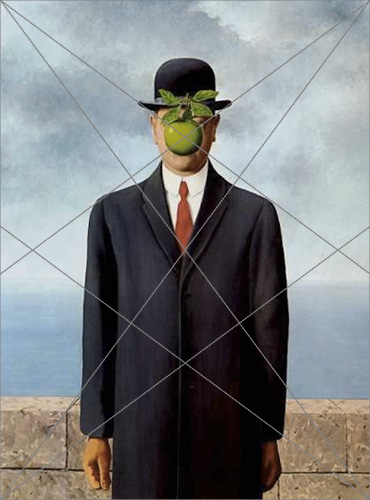
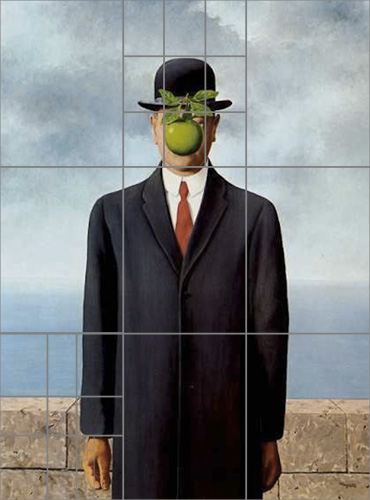
René Magritte, Son of Man (harmonic diagonals and thirds)
Salvador Dali did not.
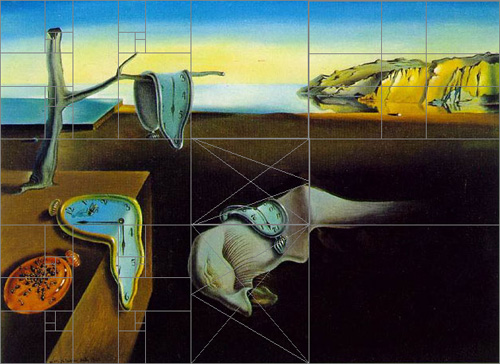
The Persistence of Memory (organized on section divisions)
If one reads his quotations both then and later he stresses the immediacy and fleeting nature of the medium, the very opposite to what you are suggesting.
Excuse me, what am I suggesting exactly? Didn't I say earlier that HC-B's ability to intuitively extract a beautiful frame from the chaos to be genius?
Here's a suggestion, read and listen to HC-B's words and have a shot of brandy every time he writes or says the word "geometry".
To suggest that Cartier-Bresson, Capa, Chim et al's successes was due to some latent classicism is missing the point ...
I'm confused here. I never mentioned Capa or Chim in any of my posts.
Latent classicism? Geometry has ALWAYS been used by visual artists. Artists have the choice to use it, to use it to a degree, to break some or all of the principles of geometry, or not to use geometry at all. Was geometry important to HC-B work? Please see my suggestion above about the brandy.
In the case of that particular photo I'm not sure I agree with your analysis ...
We'll have to agree to disagree.
... but it has a complex circular serpentine pattern that leads the eye around the frame it also contains and retains ones attention on the subjects....
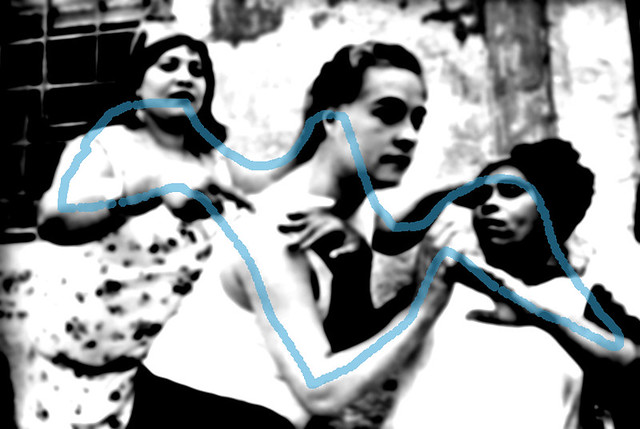
This is an arabesque; the curvilinear elements that "leads the eye around the frame," as you say. The rectangles used in the root-system have a subterranean geometry that offers unity, variety, order, and natural arabesques. The golden spiral, say, is an arabesque. Those using a Root-4 commonly employ a natural arabesque similar to the movement of a cosine wave, for example.
Nando
Well-known
... well except it's a dead ringer for Matisse's La Danse
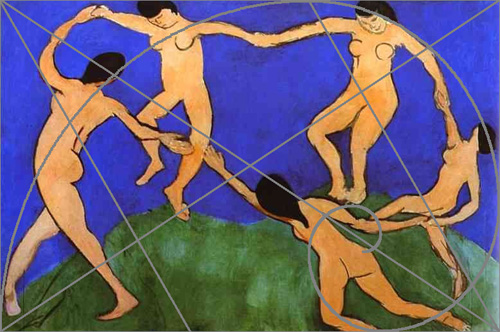
La Danse (1909 version) with the baroque diagonal (bottom-left to top-right) with it's reciprocals, the sinister diagonal (top-left to bottom-right) and the logarithmic spiral.
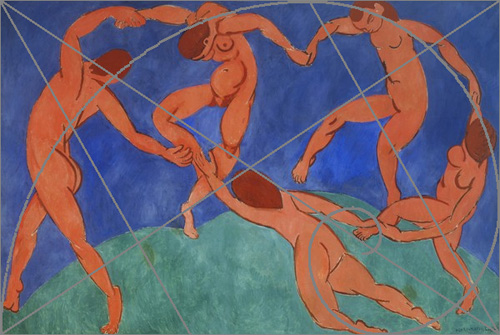
La Danse (1910 version) with same scheme as above.
... and looks nothing like that Botticelli
Poor, poor Botticelli...
Nando
Well-known
What is interesting for the practitioner in my opinion is the idea of the possibility to use a probably culturally evolved language and grammar of form and symbols to express an idea more clearly in a visual way to those familiar with the language.
YESS!!!!! Exactamente!
charjohncarter
Mentor
Lively discussion, I hope it doesn't degenerate. Nando has good ideas and can see many forms I can't. But I'm willing to learn; keep it up.
I am, maybe like many, not familiar with the, to me, loose terms of composition. For instance I have read Arabesque in this thread. But I found this which might help with some of the terms:
http://www.dcolegrovephotography.com/photo-tools/composition-guide.html
I am, maybe like many, not familiar with the, to me, loose terms of composition. For instance I have read Arabesque in this thread. But I found this which might help with some of the terms:
http://www.dcolegrovephotography.com/photo-tools/composition-guide.html
Nando
Well-known
From Burk Uzzle:
(Henri’) Cartier-Bresson once told me to go study the Quattrocentro Painters (of the early Renaissance). It was wonderful advice and they inform most of my work.
Did any of the folks critiquing Cartier-Bresson's work think this had any value?
Well, what I got from it was that Quattrocentro Painters relied completely on geometry and geometric relationships for constructing their compositions. Of course, given my biases, that's probably what would be expected from me.
Now the observation of the use of depth is important if you take into consideration what preceded them; the Byzantine artists. Much of the art at this time was for the purposes of the church. Byzantine artists created blatent 2-dimensional paintings to avoid creating false idols. I believe that the knowledge to create realistic 3-dimensional forms existed, as the Greeks did it before. However, Byzantine artists created primarily 2-dimensional images. Quattrocentro painters started breaking away from this by adding depth. The quattrocentro painters eventually lead to the Renaissance.
Now if the use of depth by Quattrocentro artists meant anything to HC-B, I do not know.
Nando
Well-known
Another thing I am interested in is how to enhance the illusion of depth in a photograph. That thought mostly arose from me having a look at the zone system. More specifically I am wondering if (a richer) gradation could be a depth cue.
This video may be useful:
http://youtu.be/w7rFrunVVwo
Nando
Well-known
Yes, I knew they were the ground breakers for Renaissance painters. Uzzle had problems with depth in his compositions early on. I think, being an artist, he worked on this constantly. HCB gave him some advice. Uzzle is a fine photographer. He was the youngest photographer ever hired by Life Magazine and was a Magnum member for many years.
I am unfamiliar with Burk Uzzle and I must admit that I didn't read the whole article. This makes more sense now.
Nando
Well-known
Thanks. Will look into his work when I have some time.
George61d
Member
I think the Quattrocento Painters were all about controlling depth. Front to back placement of objects to create the illusion of depth. That's what I got out of studying them. I could be wrong..
I finally got some time last night to look up your reference. At first glance there are three aspects to them: Realism, and control of depth through perspective and light. But that is only through a cursory glance to be honest. More reading is required
George61d
Member
Anyway, I think HCB gets too much credit for always having done everything at the decisive moment such that there were never any editing decisions from contact sheets and resulting outtakes .
That is one of the points I made in the post. I agree that this is not the right definition of the decisive moment. However, one does have to give credit to HCB for his overall success rate
Sparrow
Mentor
Yes, and what is the problem? Aren't you doing the same?
Thanks for the history lesson. I'm very familiar with Cartier-Bresson life, having read numerous books about him multiple times. He studied under André Lhote from 1927 to 1930. André Lhote taught the root-system of design. Its not Greek or from the Renaissance. The golden ratio and the root-system of design has been employed continuously throughout the history of art, design, sculpture, calligraphy, architecture, etc. everywhere; in the West, in Africa, in the Orient, in the Middle East and in the Americas.
I'm not sure what you are trying to get at here. Are you saying that HC-B would abandon fundamentals of drawing after associating himself with the surrealists? If so, why?
René Magritte did not.


René Magritte, Son of Man (harmonic diagonals and thirds)
Salvador Dali did not.

The Persistence of Memory (organized on section divisions)
Excuse me, what am I suggesting exactly? Didn't I say earlier that HC-B's ability to intuitively extract a beautiful frame from the chaos to be genius?
Here's a suggestion, read and listen to HC-B's words and have a shot of brandy every time he writes or says the word "geometry".
I'm confused here. I never mentioned Capa or Chim in any of my posts.To be frank, I respect Capa and Chim very much as photographers and photojournalists. But personally, I don't regard them as visual artists in the same sense as HC-B.
Latent classicism? Geometry has ALWAYS been used by visual artists. Artists have the choice to use it, to use it to a degree, to break some or all of the principles of geometry, or not to use geometry at all. Was geometry important to HC-B work? Please see my suggestion above about the brandy.
We'll have to agree to disagree.
This is an arabesque; the curvilinear elements that "leads the eye around the frame," as you say. The rectangles used in the root-system have a subterranean geometry that offers unity, variety, order, and natural arabesques. The golden spiral, say, is an arabesque. Those using a Root-4 commonly employ a natural arabesque similar to the movement of a cosine wave, for example.
No I don't agree at all, while I accept that artists and designers used classical geometric constructions for the last 2,500 years ... I have used them myself for the past 40 years now, I reject the idea that drawing random classical construction lines over some well known spontaneous photograph is of any use to anybody. I think you are selecting images that fit your theory then shoehorning them into it, rather than analysing what you see in them with an open mind.
I insist pi, phi, and root-2 come to us from Classical or Hellenistic Greece, although they, the Greeks, may well have called some of it Egyptian
I believe Henri was part of the avant garde, as seems clear from the from the historic record. He made his career in photography not in fine art or architecture why on earth would he have chosen to apply the cognitive geometry of Classical Theory in preference to the intuitive Gestalt Theory?
Arabesque means in the Arab style it is almost always applied to symmetrical design elements, tiles, filigree, carpets and the like.
Sparrow
Mentor
Oh ... and before attributing the use of depth in art to the Quattrocento (they were Gothic BTW) one should really lean something about the Illusionistic Style of Roman wall painting from the first century AD ... and be aware of references to similar Hellenistic painting used for theatre backdrops as far back as 400 BC.
However, one does have to give credit to HCB for his overall success rate
Success rate? How did you quantify it?
robklurfield
eclipse
HCB's success rate? Easy. 100%. What I mean is that he made a living at photograpy. What more do we need to measure success? How many of us are doing that?
 I'm kidding here. But, let me pose the question in a different way: how many of us are the subject of books, exhibitions and unending debate?
I'm kidding here. But, let me pose the question in a different way: how many of us are the subject of books, exhibitions and unending debate?
Now, to answer George61d's real question, I have no idea and I suspect no one else has a completely reliable one either (wouldn't that require access to more or less all of his negatives and contact sheets?). But, really, why does it matter? Can we assume that HCB, like anyone else in the arts, is mostly defined by the output he shared, not the output he withheld or destroyed? Aren't the editing choices more important than how many steps he took to get there or how many outtakes were left behind?
All that aside, HCB had a good eye for action unfolding in front of him. That's certainly one of the reasons we talk about him, isn't it? But, when you're in the field and not controlling the action, it is inevitable that not every frame is going to look the way you want. So, personally, I don't think much about what percentage were keepers versus discards.
Assuming that an image like the guy leaping over the puddle wasn't staged, HCB's patience and quickness (qualities that can be at odds with one another if one doesn't exercise a great deal of discipline) aided what his eye alone couldn't have made happen. You can compose that scene all day long, but unless and until someone does something interesting in traversing the puddle, it's just another nice picture of some water on pavement. What if the jumper decided instead to walk around the obstacle instead of hopping over it? Not a terribly interesting image.
Now, to answer George61d's real question, I have no idea and I suspect no one else has a completely reliable one either (wouldn't that require access to more or less all of his negatives and contact sheets?). But, really, why does it matter? Can we assume that HCB, like anyone else in the arts, is mostly defined by the output he shared, not the output he withheld or destroyed? Aren't the editing choices more important than how many steps he took to get there or how many outtakes were left behind?
All that aside, HCB had a good eye for action unfolding in front of him. That's certainly one of the reasons we talk about him, isn't it? But, when you're in the field and not controlling the action, it is inevitable that not every frame is going to look the way you want. So, personally, I don't think much about what percentage were keepers versus discards.
Assuming that an image like the guy leaping over the puddle wasn't staged, HCB's patience and quickness (qualities that can be at odds with one another if one doesn't exercise a great deal of discipline) aided what his eye alone couldn't have made happen. You can compose that scene all day long, but unless and until someone does something interesting in traversing the puddle, it's just another nice picture of some water on pavement. What if the jumper decided instead to walk around the obstacle instead of hopping over it? Not a terribly interesting image.
HCB's success rate? Easy. 100%. What I mean is that he made a living at photograpy. What more do we need to measure success? How many of us are doing that?I'm kidding here. But, let me pose the question in a different way: how many of us are the subject of books, exhibitions and unending debate?
I get what you are saying Rob... there's no debating his success. However, we have no clue how many photos he's taken in order to quantify a success rate as a ratio of good to bad. Nor does it really matter since publications, books, museums, galleries, etc don't keep stats like it is a sport.
Nando
Well-known
No I don't agree at all,
Fair enough.
I reject the idea that drawing random classical construction lines over some well known spontaneous photograph is of any use to anybody.
Random? Spontaneous?
Perhaps its not of any use to you. It is of use to me and it is of use to many people I know that are interested in art. Why do you speak for everybody?
I think you are selecting images that fit your theory then shoehorning them into it, rather than analysing what you see in them with an open mind.
Take a good look in the mirror.
I insist pi, phi, and root-2 come to us from Classical or Hellenistic Greece, although they, the Greeks, may well have called some of it Egyptian
It would difficult to explain why ancient peoples of China and of the Americas also used these systems without any contact with the Greeks or Egyptians. But what every you say Your Majesty.
.... why on earth would he have chosen to apply the cognitive geometry of Classical Theory in preference to the intuitive Gestalt Theory?
Arabesque means in the Arab style it is almost always applied to symmetrical design elements, tiles, filigree, carpets and the like.
I'm not sure if Batman informed you Sparrow but some English words have words have more than one meaning.
http://dictionary.reference.com/browse/arabesque
I know that you are going to continue this until you are blue in the face. So, I know that you'll be relieved that I won't be wasting any more of my valuable time here.
gho
Well-known
I think the idea that there are some well known let's say "design patterns" that are actively used by painters to construct an image is not too far fetched. And that those patterns are perceivable to those who are actually educated in these techniques - for example by studying visual arts - seems to be reasonable enough to me. And the usability of those principles in photography is easy to demonstrate by simply employing them oneself.
MickH
Well-known
Many years ago I took this photograph, I think you'll see the Batman influence as employed by HC-B.



paulfish4570
Mentor
bwahahahahahahahahahaha! 
Share:
-
This site uses cookies to help personalise content, tailor your experience and to keep you logged in if you register.
By continuing to use this site, you are consenting to our use of cookies.

